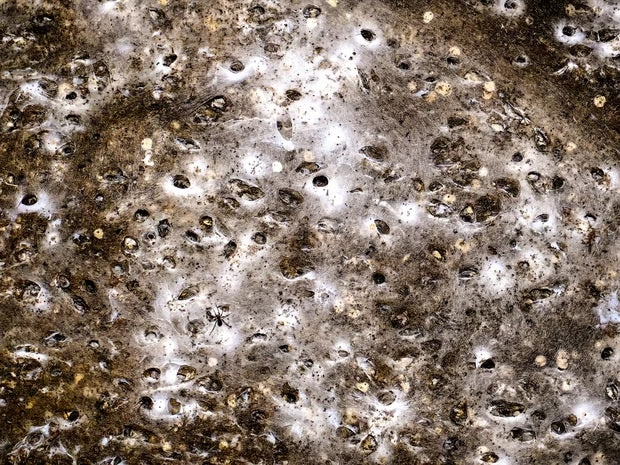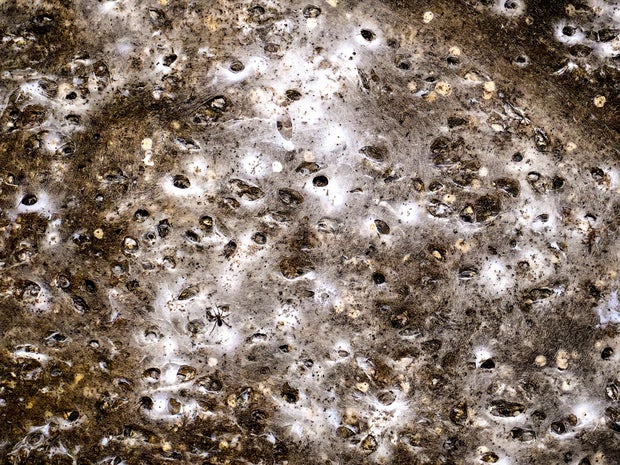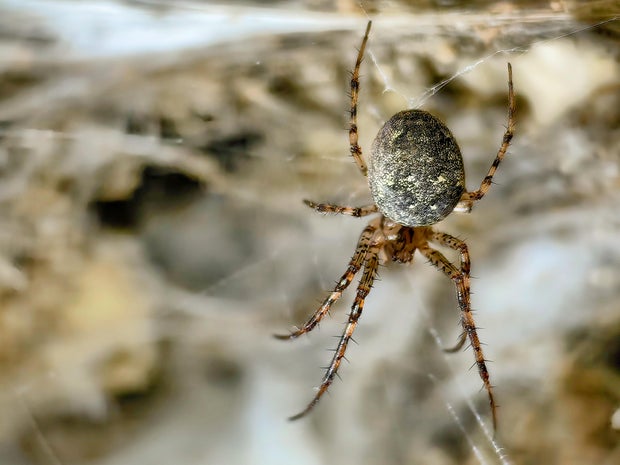What is thought to be the world’s largest-known spider’s web, housing tens of thousands of arachnids, has been discovered in a cave on the Albanian-Greek border.
After researchers published their findings of two different spider species peacefully cohabiting in a giant colony nestled in a pitch-black, sulfur-rich cave, evolutionary biologist Lena Grinsted likened the “extremely rare” occurrence to humans living in an apartment block.
“When I saw this study, I was very excited because … group living is really rare in spiders,” Grinsted, a senior lecturer at the U.K.’s University of Portsmouth, told The Associated Press. “The fact that there was this massive colony of spiders living in a place that nobody had really noticed before — I find extremely exciting.”
The results of the study, published last month in the journal Subterranean Biology, spread rapidly online due to the striking images of the giant 1,140-square-foot spider’s web, a carpet-thick sprawl stretching along a narrow passage wall inside Sulfur Cave, which extends into Albania from its entrance in Greece.
This arachnophobe’s worst nightmare was quickly labelled the “world’s largest spiderweb.”
Istvan Urak / AP
But the most surprising thing about the spider colony — which boasts an estimated 110,000 spiders — had less to do with its size and more to do with what scientists found inside the huge mass of funnel-shaped webs.
Two different spider species — about 69,000 Tegenaria domestica, or common house spider, and 42,000 Prinerigone vagans — were living side by side and thriving. The behavior, which had never been observed before, stunned scientists as, typically, the larger house spider would prey on its smaller neighbor.
“So often if you have spiders in close vicinity, they will fight and end up eating each other,” said Grinsted, who was not part of the cave study but has extensively researched spiders. “We can sometimes see that if there’s an abundance of food that they sort of become a bit less aggressive.”
In addition to spiders, the terrestrial fauna in the cave include centipedes, terrestrial isopods, scorpions and beetles, the researchers said.
“In the stream passage located close to the cave entrance, a dense swarm of adult chironomid flies fills the air in the immediate vicinity of the sulfidic stream, and a large portion of the cave wall is covered by a massive colonial spider web,” the study’s authors write.
Abundant food source
Scientists are keen to understand how and why the two species came to coexist peacefully in a “permanently dark zone” about 160 feet from the entrance of the cave, carved out by the waters of the Sarandaporo River to form the Vromoner Canyon. (The study’s authors note that Vromoner means “smelly water” in Greek.)
Part of the answer, the research suggests, may lie in the combination of the estimated 2.4 million midge flies that buzz around the spider colony — an “unusually dense swarm” that provides a constant food source in an otherwise predator-scarce environment. The scientists also speculate that the friendly living arrangement could be a result of darkness impairing the spiders’ vision.
However, Grinsted says it is more likely that the larger spiders evolved or simply grew accustomed to responding to vibratory cues when the small flies land on their silken web — and maybe don’t attack otherwise.
Istvan Urak / AP
“Spiders, in general, are not particularly good at seeing stuff … and that includes these two species,” she said. She added that the two species might cooperate “to some extent in building the web … but I think it’s highly unlikely that they cooperate in anything else like prey capture, in brood care, or looking after each other’s babies.”
Grinsted draws parallels between the cohabiting spiders and how humans tend to coexist in apartment blocks.
“You’re very happy to share the stairs, the lift,” she said. “But if anybody comes into your living room and you haven’t invited them, you’ll be aggressive towards them.”
She added that while many spiders are “typically solitary, very aggressive” toward other critters, the cohabitation of two species is “relatively common” once spiders have evolved the ability to live in groups.
“But again, because these two species have never been found to live together and never been found to live in groups, it makes it particularly exciting,” she said.
“The web is dense — like a blanket”
Blerina Vrenozi, a biologist and zoologist at the University of Tirana, in Albania, who co-authored the research paper, told the AP that the expeditions this year helped understand “how this mystery existed in there.”
“The DNA is interesting because they revealed that the species which live inside the cave is different from the one which lives outside the cave,” she said. “So it’s the same species, but different DNA.”
The cave colony’s giant web was first observed in 2021 by a team of Czech speleologists led by Marek Audy. A year later, the Czech team expanded to include scientists from multiple universities, which led to the recently published scientific paper.
“The web is dense; it’s more like a blanket, and when there’s danger, the female crawls back and hides, and no creature of a higher order can dig her out of there,” Audy said. “Spiders in the cave lay about a third of the eggs compared to spiders that live outdoors. Because it’s certain that they will raise their offspring there … so they can afford to lay fewer eggs.”
Istvan Urak / AP
Audy added that the cave, which is also home to large bat colonies, also thrive on the abundance of midges inside the humid, dark space. “They are constantly having a party there, both the spiders and the bats,” he said.
Seemingly ideal environment
The study noted that the methodology used might “slightly overestimate” the total population count of spiders in the colony, as some funnel webs may be abandoned or unoccupied. However, other experts agree that the team’s exciting new research could offer broader evolutionary clues and deserves deeper study.
Sara Goodacre, professor of evolutionary biology and genetics at the School of Life Sciences, at the U.K.’s University of Nottingham, says these kinds of research projects help pave the way for more studies that could prove “fundamental to our understanding of what forces shape the world around us — spidery or not.”
“Natural selection will favor the ‘best’ strategies … the ‘winning strategy,’ whatever this is,” she said. “My guess is that the benefits of being part of this community far outweigh the costs.”
She added that if the dynamics in the seemingly ideal environment of abundant food and relative safety were to change, “then ‘freeloading’ will emerge and it will all break down.”
The politics of coexistence will hopefully not prove trickier above ground. Audy said that Albania has already asked which side the newly famous spiders lie.
“From a conservation point of view, we did something interesting there and marked out a border,” he said. “I just looked into it — and the spider web is on the Greek side.”
The discovery of the massive web comes just months after Australian scientists discovered a new species of the deadly funnel-web spider that is bigger and more venomous than its relatives, nicknaming it “Big Boy.”












